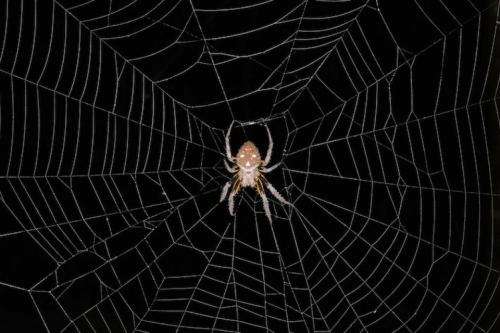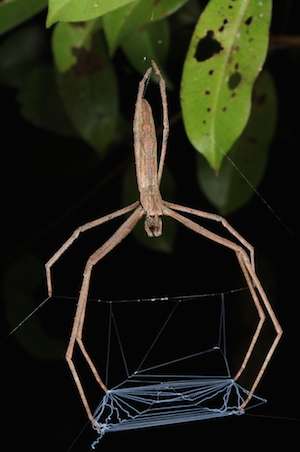Research contradicts previous hypotheses about the evolution of orb weavers

Armed with new DNA evidence, a George Washington University biologist has reopened the mysterious case of the origin of orb weaving spiders. His research could reverse decades of thought about the eight-legged artist's 230-million-year-old history.
Orb weavers, which make up nearly one third of the 45,000 described species of spiders, are best known for the intricate, silk masterpieces they weave. The group of arachnids is not only abundant, but also remarkably diverse. Each species builds its own, unique web, ranging from expertly-engineered, geometric designs to tangled messes of white fluff.
Plotting the genealogical relationships between species is key to understanding spider diversification, says Gustavo Hormiga, a biology professor in the Columbian College of Arts and Sciences. But researchers have long debated a crucial question of web architecture evolution.
The controversy, which dates back to at least the 1880s, involves the emergence of two main groups of orb weavers: one that spins the capture spiral of its web with dry silk, formed from thousands of fine looped fibrils, and the other that uses stickier thread coated with a glue-like glycoprotein.
Since these two groups spin webs in similar fashions, scientists have primarily supported the theory that the two groups of webs (cribellate and ecribellate) derived from a single origin.
However, results from a 2014 preliminary study led by Dr. Hormiga suggest the very opposite: the two types of webs actually evolved independently or had a much more ancient origin than is commonly thought, according to the researchers. Further, the new data shows that other families—such as jumping spiders and wolf spiders—may have actually descended from orb weaving ancestors.

"Either alternative demands a major reevaluation of our current understanding of the spider evolutionary chronicle," the researchers write in their paper published this past summer in the journal Current Biology.
Now, with new funding from the National Science Foundation, Dr. Hormiga and his colleagues from Harvard University will expand on this research using modern DNA sequencing methods. They are seeking to reconstruct a new evolutionary tree that will depict the relationships between the 21 known families of orb weavers and their close relatives.
The new study will address the same question that Dr. Hormiga and an international team of researchers tackled four years ago—but with fresh new evidence.
In their 2011 study, the researchers supported the "single origin" hypothesis. But these results and other molecular efforts relied on only a handful of genes, which may have led to pitfalls in their results, says Dr. Hormiga.
Using new methods to gather and compare genetic data in numerous spiders, Dr. Hormiga says his new study will produce a more accurate and complete picture of orb weaver evolution, allowing the researchers to finally answer the long-standing question of the spiders' origin.
"Understanding the evolutionary relationships of things that evolved more than two hundred million years ago in a relatively short timespan is a very difficult problem to solve. It's just not so easy," Dr. Hormiga says. "With next generation sequencing techniques, you can collect magnitudes of more data faster and cheaper."
He equates the research to retrying a court case with a new set of witnesses.
"Ideally, if every witness tells the truth, what really happened will emerge. But some of them might not be telling the truth. Or some of them think they're telling the truth, but the evidence sometimes is misleading," Dr. Hormiga says. "But now we have new methods and a ton of data."
Starting this summer, Dr. Hormiga will travel the world—from Madagascar to New Zealand— searching for and collecting spiders to bring back to his lab at GW. Collecting new specimens is key since DNA from spider samples in museums degrades easily and is not ideal for this type of molecular work.
Dr. Hormiga is hopeful that the project will provide a fundamental comparative basis for studies on a wide variety of topics, including silk biology, sexual selection and venom evolution. And it will tell the full story of one of our planet's dominant predators.
"We're sending probes to outer space to find what kinds of life forms may be out there," Dr. Hormiga says. "But we have a relatively poor understanding of diversity on Earth."
More information: "Phylogenomic analysis of spiders reveals nonmonophyly of orb weavers." Curr Biol. 2014 Aug 4;24(15):1772-7. DOI: 10.1016/j.cub.2014.06.035. Epub 2014 Jul 17.
"Tangled in a sparse spider web: single origin of orb weavers and their spinning work unravelled by denser taxonomic sampling." Proc. R. Soc. B:2011 -;DOI: 10.1098/rspb.2011.2011. Published 2 November 2011
Journal information: Current Biology
Provided by George Washington University





















